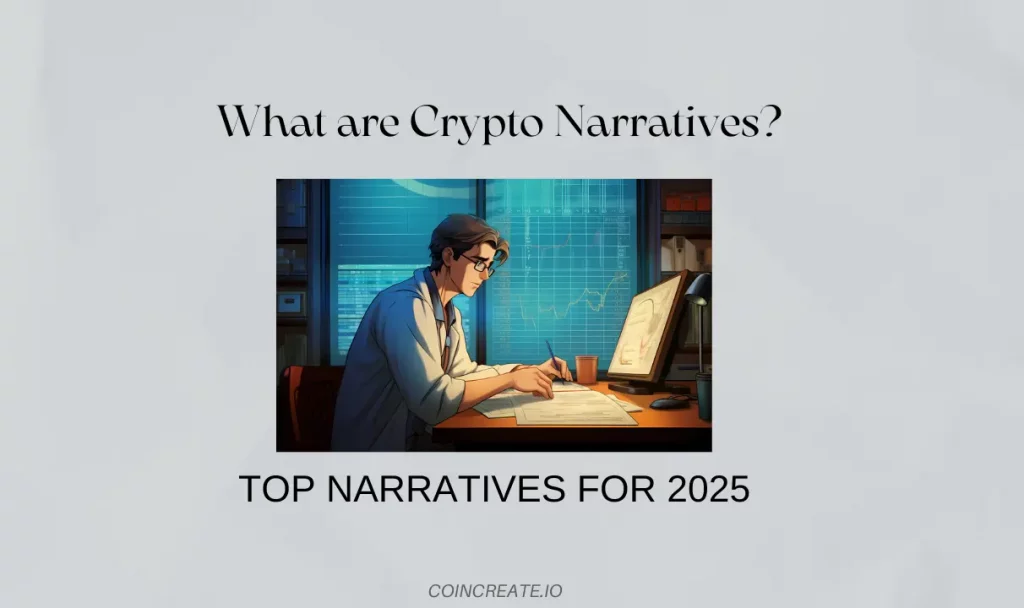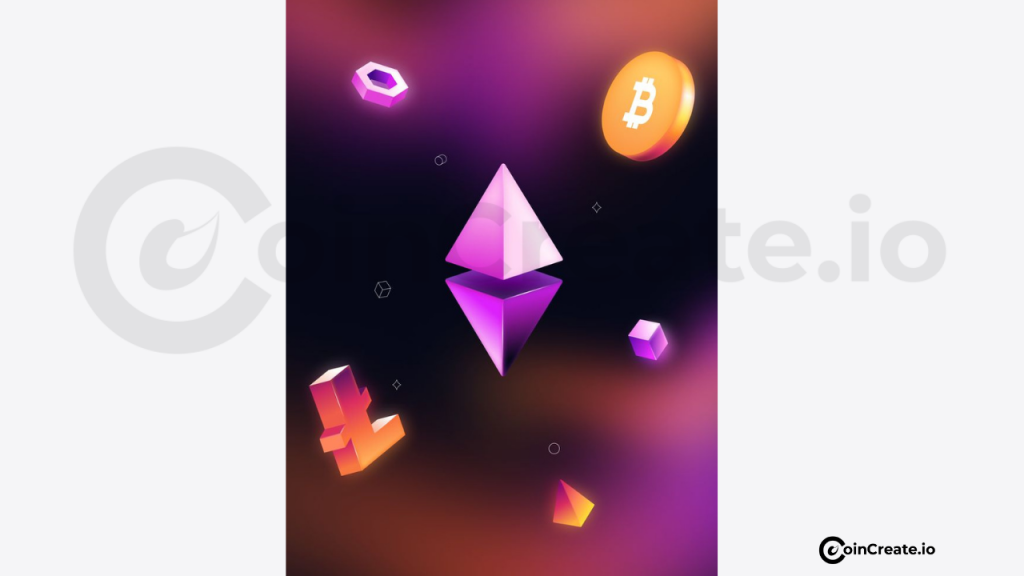What are Crypto Narratives? 7 Best Narratives for 2025
The cryptocurrency market is a dynamic ecosystem, constantly evolving with new technologies, trends, and narratives that shape investor sentiment and drive market cycles. As we move into 2025, understanding these narratives is crucial for anyone looking to navigate the crypto landscape successfully. This guide explores the dominant crypto narratives of 2025, including Artificial Intelligence (AI), Decentralized Physical Infrastructure Networks (DePIN), Tokenized Real-World Assets (RWAs), and more, providing insights into their potential impact and how they can inform strategic investment decisions.

Crypto narratives are the overarching themes, ideas, or beliefs that influence how individuals perceive and value cryptocurrencies and blockchain technologies. These narratives often stem from technological innovations, socioeconomic developments, or the collective aspirations of the crypto community. They serve as a framework for understanding the potential benefits, risks, and long-term implications of specific assets or blockchain-based solutions.
Examples of prominent crypto narratives include:
- Bitcoin as Digital Gold: Positioned as a store of value and a hedge against economic uncertainty.
- Blockchain as a Disruptive Force: Driving innovation across various sectors, including decentralized finance (DeFi), supply chain management, and digital identity.
- AI Integration: Showcasing the increasing integration of AI into blockchain solutions for enhanced efficiency and security.
- Tokenized Assets: Converting real-world assets into digital tokens to unlock liquidity and fractional ownership.
Why are Crypto Narratives Important?
Understanding crypto narratives is essential for several reasons:
Driving Market Sentiment
Narratives can create bullish or bearish trends, influencing investor behavior and market dynamics. Positive narratives attract capital inflows, while negative narratives can trigger sell-offs.
Informing Investment Decisions
Investors often rely on narratives to make informed investment decisions, predict market cycles, and identify promising projects.
Promoting Adoption
Narratives help simplify complex technologies and make them more accessible to a broader audience, fostering adoption and driving growth.
Fueling Innovation
Narratives encourage developers and entrepreneurs to build new solutions and applications that align with emerging trends, further accelerating innovation in the crypto space.
Why Narratives Matter in 2025
In 2025, crypto narratives are more crucial than ever for navigating market cycles and identifying opportunities. Here’s how they matter
- Shaping Hype Cycles: Crypto narratives drive the lifecycle of hype cycles, starting with the excitement of early adopters and escalating into widespread FOMO (fear of missing out). This initial enthusiasm often inflates valuations, only to be followed by corrections when speculative bubbles pop. For example, narratives like Bitcoin halving or Ethereum upgrades historically trigger bull runs by creating anticipation and speculative buying.
- Influencing Investor Sentiment: Narratives provide a framework for understanding the potential of emerging technologies or assets, impacting both retail traders and institutional investors. Positive narratives can attract capital inflows, while negative ones can lead to sell-offs.
- Driving Price Action: Market psychology plays a significant role in crypto price movements. Narratives amplify demand as investors rush to capitalize on perceived opportunities, often disregarding risks during periods of euphoria. Examples include the rapid appreciation of memecoins or the adoption of liquid staking mechanisms, both driven by compelling stories rather than intrinsic value.
- Encouraging Mass Adoption: Narratives simplify complex technologies for broader audiences, enabling mass adoption. For instance, decentralized finance (DeFi) and NFTs gained traction because their narratives resonated with both developers and users.
- Providing a Roadmap for 2025: Crypto narratives are pivotal for navigating market cycles and identifying opportunities in 2025. They help investors and innovators alike focus on trends and future-proof their portfolio.
Top Crypto Narratives for 2025
Several key narratives are poised to dominate the crypto landscape in 2025. Let’s delve into each of these narratives, exploring their potential impact and key players
1. Artificial Intelligence (AI) in Blockchain
The convergence of AI and blockchain is one of the most transformative narratives in the crypto space. AI can enhance blockchain’s capabilities in several ways
AI-Driven Smart Contracts
AI can optimize smart contract execution, automate complex tasks, and improve efficiency in sectors like trading, DeFi, and supply chain management
AI Agents in Crypto
AI agents can autonomously manage decentralized systems, providing enhanced security, fraud detection, and market analysis.
DeFAI (Decentralized AI Finance)
The integration of AI with DeFi is revolutionizing yield optimization and risk management, creating new opportunities for investors.
Better Security and Transparency
Blockchain, enhanced with AI, provides greater control over the usage of data across industries.
Real-Time Adaptability
AI-enhanced blockchains make it easier to build dynamic applications that can analyze complex data.
Projects like Fetch.ai, SingularityNET, and Ocean Protocol are at the forefront of this narrative. They are developing AI-powered solutions for various use cases, from optimizing supply chains to creating decentralized marketplaces for data.
2. Decentralized Finance (DeFi) and Yield Farming
DeFi continues to be a major force in the crypto market, offering innovative financial services and yield-generating opportunities. The DeFi narrative is driven by
Resurgence and Expansion
Pro-crypto policies and improved cross-chain solutions are fueling the growth of DeFi, making it more accessible and inclusive.
Ethereum and Solana Ecosystems
DeFi projects on Ethereum and Solana, such as Aave, Raydium, and Pendle Finance, are gaining traction due to their robust infrastructure and yield farming opportunities.
Innovations in Lending and Borrowing
DeFi platforms are developing new lending and borrowing mechanisms that offer better terms and greater flexibility for users.
Yield Optimization Strategies
Yield farming, liquidity mining, and other strategies are enabling users to earn passive income from their crypto assets.
3. Decentralized Physical Infrastructure Networks (DePIN)
DePIN represents a paradigm shift in how physical infrastructure is managed and owned. By combining blockchain technology with real-world assets, DePIN aims to create decentralized alternatives to traditional infrastructure
Tokenization of Physical Assets
DePIN projects tokenize physical assets, such as communication networks, energy grids, and IoT devices, enabling decentralized ownership and governance.
Community-Driven Networks
Participants contribute resources and earn tokens for their contributions, creating a community-driven ecosystem.
Decentralized Governance
Decisions are made collectively by network participants, ensuring transparency and resilience.
Bridging Digital and Physical Divide
DePIN unlocks a lot of new possibilities and has the potential to be implemented into existing industries.
Projects like Helium and Hivemapper are pioneering the DePIN narrative, building decentralized wireless networks and mapping solutions powered by community contributions.
4. Memecoins
Memecoins continue to capture attention in the crypto market due to their community-driven hype and potential for rapid gains. While highly speculative, memecoins can offer lucrative opportunities for those who understand the market dynamics
Community-Driven Narratives
Memecoins are driven by strong online communities and viral marketing campaigns
High Volatility
Memecoins are known for their extreme volatility, offering the potential for significant gains but also carrying high risks.
Cultural Trends
They're also reflective of the current zeitgeist and pop-culture, marking them as potential investment opportunities.
5. Tokenized Real-World Assets (RWAs)
Tokenizing real-world assets is emerging as a key narrative, promising to unlock trillions of dollars in liquidity and create new investment opportunities
Asset Tokenization
Physical assets, such as real estate, commodities, and art, are converted into digital tokens on the blockchain.
Increased Liquidity
Tokenized assets can be traded 24/7 on global markets, increasing liquidity and accessibility.
Fractional Ownership
Investors can own small portions of high-value assets, democratizing access to investment opportunities.
Transparency and Efficiency
Blockchain technology ensures that ownership records are immutable and verifiable, increasing transparency and efficiency in asset management.
6. Stablecoins and Crypto ETFs
Stablecoins and crypto ETFs are playing a crucial role in driving mainstream adoption of cryptocurrencies
Stablecoins as a Gateway
Stablecoins provide a less volatile entry point for new users, facilitating easier access to the crypto market.
Crypto ETFs for Institutional Investors
Crypto ETFs are increasing institutional participation by offering regulated investment options tied to cryptocurrencies.
Compliance with Regulations
Stringent compliances make them ideal for all kinds of users.
7. Liquid Staking and Restaking on Bitcoin
Liquid staking and restaking mechanisms are offering new ways to earn rewards on Bitcoin holdings
Liquid Staking
Allows users to stake their Bitcoin and receive liquid tokens that can be used in DeFi applications.
Restaking
Enables users to restake their staked Bitcoin to earn additional rewards.
The Rise of AI, DePIN, and Tokenized Assets Key Narratives for 2025
As the crypto ecosystem evolves, certain narratives are emerging as game-changers for 2025. Among these, Artificial Intelligence (AI), Decentralized Physical Infrastructure Networks (DePIN), and Tokenized Real-World Assets (RWAs) stand out for their potential to reshape industries and drive blockchain adoption. Let’s explore these narratives in detail.
Artificial Intelligence (AI) in Blockchain
AI is transforming blockchain by introducing automation and adaptability into smart contracts. These contracts can now analyze real-time data, optimize execution conditions, and self-adjust based on market dynamics. This innovation enhances efficiency in sectors like trading, DeFi, and supply chain management.
AI agents are being deployed to manage decentralized systems autonomously. From fraud detection to market analysis, these agents bring a new level of intelligence and security to blockchain ecosystems. The integration of AI with DeFi (DeFAI) is also revolutionizing yield optimization and risk management, creating high-reward opportunities for investors.
Decentralized Physical Infrastructure Networks (DePIN)
DePIN represents a paradigm shift in how physical infrastructure is managed. By combining blockchain technology with real-world assets like communication networks, energy grids, and IoT devices, DePIN decentralizes ownership and governance. Participants contribute resources such as bandwidth or storage and are rewarded with tokens for their contributions.
How DePIN Works:
Tokenization: Physical assets are represented as tradable tokens within the network.
Smart Contracts: Automated agreements ensure fair resource distribution and payment execution.
Decentralized Governance: Decisions are made collectively by participants, ensuring transparency and resilience.
DePIN bridges the gap between digital assets and physical systems, enabling decentralized alternatives to traditional infrastructure.
For example:
- Projects like Helium use community-provided WiFi hotspots to build decentralized wireless networks.
- Decentralized energy grids allow communities to trade renewable energy locally without relying on centralized utilities.
With over 650 projects across sectors like AI, energy, and telecommunications, DePIN is rapidly becoming a cornerstone of Web3 infrastructure.
Tokenized Real-World Assets (RWAs)
Tokenization involves converting physical assets—such as real estate, commodities, or even art—into digital tokens on the blockchain. These tokens represent ownership or rights over the underlying asset.
Benefits of Tokenization:
- Increased Liquidity: Tokenized assets can be traded 24/7 on global markets.
- Fractional Ownership: Investors can own small portions of high-value assets like real estate or luxury goods.
- Transparency: Blockchain ensures that ownership records are immutable and verifiable.
Tokenized RWAs are expected to unlock trillions of dollars in liquidity by making traditionally illiquid assets accessible to a broader audience. This narrative is particularly appealing to institutional investors looking for secure entry points into crypto markets.
Conclusion & Investment Considerations
As we explore the top crypto narratives of 2025, including AI integration, DePIN, tokenized real-world assets, and others, it’s crucial to understand how these trends can inform investment decisions. Here’s a guide on leveraging these narratives for strategic planning and risk management
Risk Analysis and Management
Narratives like memecoins and AI-driven projects can be highly speculative and volatile. Investors should be cautious and conduct thorough risk assessments before investing.
Emerging narratives like DePIN and tokenized assets may face regulatory challenges. Investors should monitor legal developments closely.
Long-Term Opportunities
The convergence of AI and blockchain offers long-term potential for innovation and efficiency improvements. Projects like Fetch.ai and SingularityNET are pioneering this space.
Tokenizing traditional assets can unlock new liquidity and investment opportunities, providing a stable long-term growth narrative.
Strategic Planning and Portfolio Diversification
Spread investments across different narratives to mitigate risk. For example, combining AI-driven projects with stablecoin investments can balance speculative and stable assets.
Keep track of market sentiment and narrative shifts. Tools like social media analytics can help identify emerging trends early.
Emerging Investments and Trends
While risky, altcoins and memecoins can offer high returns if timed correctly. Conduct thorough research and sentiment analysis before investing.
DeFi projects on Ethereum and Solana offer stable yield opportunities. Monitor protocol updates and market conditions to optimize returns.
Final Conclusion: Navigating the Crypto Landscape Effectively
In conclusion, effectively leveraging crypto narratives demands a blend of risk management, forward-thinking strategic planning, and a strong grasp of emerging trends. Diversifying investments across promising narratives such as AI, DePIN, and tokenized assets enables investors to position themselves for potential short-term gains and robust long-term growth within the ever-changing crypto ecosystem.

